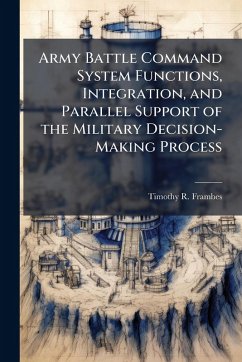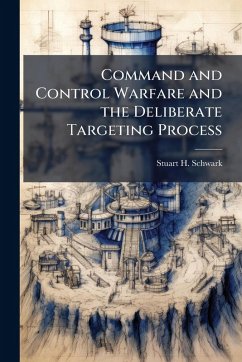
Force XXI Technology and the Cognitive Approach to the Military Decision Making Process
Versandkostenfrei!
Versandfertig in über 4 Wochen
15,99 €
inkl. MwSt.

PAYBACK Punkte
8 °P sammeln!
The United States Army has invested millions of dollars and countless man hours in information technology. This investment in technology is a result of digital capabilities unimagined several years ago. It stands to reason, if better information is available faster, that better decisions will follow. The key to better decision making through digitization lies in situational awareness based on informational awareness. This knowledge will contribute to certainty and a temporal advantage over the enemy. Digital technology and the Force XXI (FXXI) efforts have tremendous potential to support decis...
The United States Army has invested millions of dollars and countless man hours in information technology. This investment in technology is a result of digital capabilities unimagined several years ago. It stands to reason, if better information is available faster, that better decisions will follow. The key to better decision making through digitization lies in situational awareness based on informational awareness. This knowledge will contribute to certainty and a temporal advantage over the enemy. Digital technology and the Force XXI (FXXI) efforts have tremendous potential to support decision making. Digital technology however, poses some daunting dilemmas for the Army. With the tremendous technological advantages come tradeoffs that may hinder a commander more than information awareness assists him. Information technology holds the key to improving the MDMP. However, exploitation of digitization requires a reexamination of the Army's decision-making concepts. The rational decision making model has organized the Army's staffs and guided collection of data in support of deliberate planning. The advent of instantaneous information through digitization permits the commander to receive data and information directly and this enables him to adjust his plans during an operation. This instantaneous information permits the commander to revise his intent and adjust plans to conform to the needs of the operations and take advantage of opportunities. Plans, therefore, can emerge from the commander's assessment of the situation and he can focus on information needed to support his decisions. Staff efforts historically focused on collection of data to support the MDMP. The staff in turn produced a plan and monitored the operation providing feedback to the commander. The decision process was formal and largely left out how the commander made decisions. However, with digitization, how the commander makes decisions, defines what he must "see" on the battlefield. This vision is This work has been selected by scholars as being culturally important, and is part of the knowledge base of civilization as we know it. This work was reproduced from the original artifact, and remains as true to the original work as possible. Therefore, you will see the original copyright references, library stamps (as most of these works have been housed in our most important libraries around the world), and other notations in the work. This work is in the public domain in the United States of America, and possibly other nations. Within the United States, you may freely copy and distribute this work, as no entity (individual or corporate) has a copyright on the body of the work. As a reproduction of a historical artifact, this work may contain missing or blurred pages, poor pictures, errant marks, etc. Scholars believe, and we concur, that this work is important enough to be preserved, reproduced, and made generally available to the public. We appreciate your support of the preservation process, and thank you for being an important part of keeping this knowledge alive and relevant.












